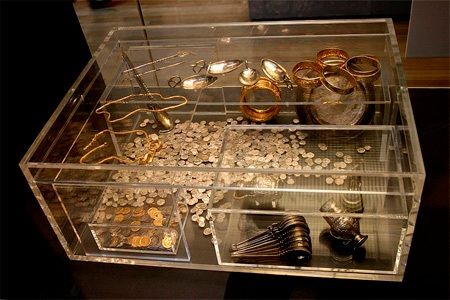3. Hoxne Hoard
On November 16, 1992, a hoard of late Roman silver and gold was discovered by a metal detectorist in the village of Hoxne in Suffolk, England.
The hoard was discovered in a farmer's field, about 2.4 kilometres southwest of the village. Peter Whatling, the tenant farmer, had lost a hammer and asked his friend Eric Lawes, a retired gardener and amateur metal detectorist, to help him look for it. While searching the field with his metal detector, Lawes discovered silver spoons, gold jewelry, and numerous gold and silver coins. After retrieving a few items, he and Whatling notified the landowners and the police, without attempting to dig out any more objects.
The next day, a team of archaeologists from the Suffolk Archaeological Unit carried out an emergency excavation of the site. The entire hoard was excavated in a single day, with the exception of numerous large blocks of unbroken material left for laboratory excavation.
The treasure was buried in a small chest filled with items made of precious metals, sorted mostly by type, with some in smaller wooden boxes and others in bags or wrapped in fabric. The coins of the hoard date it after AD 407, which coincides with the end of Britain as a Roman province. The owners and their reasons for burying the treasure are unknown, but it was carefully packed and the contents appear consistent with what one very wealthy family might have owned.
The hoard consists of 14,865 Roman gold, silver, and bronze coins from the late fourth and early fifth centuries, and approximately 200 items of silver tableware and gold jewelry.
The objects are now in the British Museum in London, where the most significant pieces and a selection of the rest are on permanent display. In 1993, the Treasure Valuation Committee valued the hoard at £1.75 million (today £3.02 million).
 INFORMATION CLUB
INFORMATION CLUB Informative Zone
Informative Zone Awareness
Awareness Spectacular Hidden Treasures Found in Recent Decades
Spectacular Hidden Treasures Found in Recent Decades INFORMATION CLUB
INFORMATION CLUB Informative Zone
Informative Zone Awareness
Awareness Spectacular Hidden Treasures Found in Recent Decades
Spectacular Hidden Treasures Found in Recent Decades
